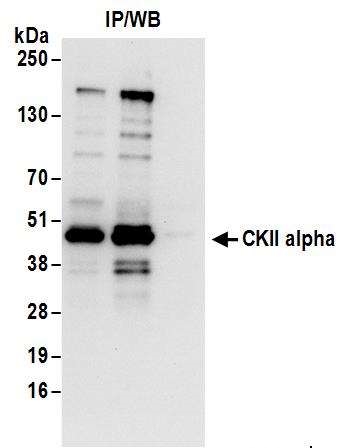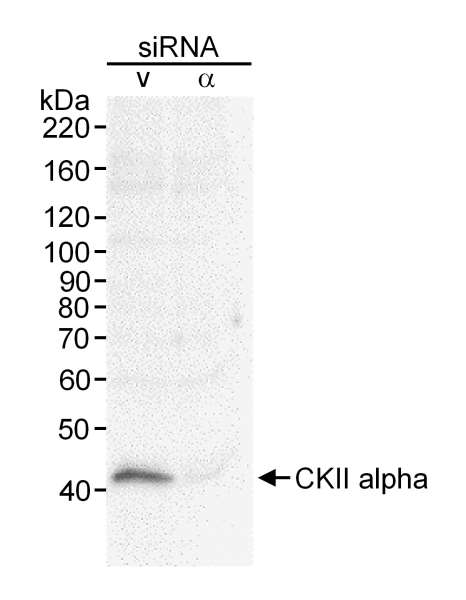Anti-CKIIα Antibody (13026)
Data
 Detection of human CKII Alpha by western blot. Sample: RIPA extract (30 µg) from HeLa cells treated with CKII alpha siRNA or vimentin siRNA (v). Antibody: Affinity purified rabbit anti-CKII alpha (Cat. No. 13026) used at 0.33 µg/ml. Detection: Chemiluminescence with a 1 minute exposure.
Detection of human CKII Alpha by western blot. Sample: RIPA extract (30 µg) from HeLa cells treated with CKII alpha siRNA or vimentin siRNA (v). Antibody: Affinity purified rabbit anti-CKII alpha (Cat. No. 13026) used at 0.33 µg/ml. Detection: Chemiluminescence with a 1 minute exposure. Detection of human CKII alpha by western blot. Samples: Whole cell lysate (50 µg) from HeLa and HEK293T cells prepared using NETN lysis buffer. Antibody: Affinity purified rabbit anti-CKII alpha antibody 13026 (lot 13026-1) used for WB at 0.2 µg/ml. Detection: Chemiluminescence with an exposure time of 30 seconds.
Detection of human CKII alpha by western blot. Samples: Whole cell lysate (50 µg) from HeLa and HEK293T cells prepared using NETN lysis buffer. Antibody: Affinity purified rabbit anti-CKII alpha antibody 13026 (lot 13026-1) used for WB at 0.2 µg/ml. Detection: Chemiluminescence with an exposure time of 30 seconds. - -
- -
Antibody DetailsProduct DetailsReactivity Species Human Host Species Rabbit Immunogen Synthetic peptide representing a portion of the protein encoded by exon 3 (LocusLink ID 1457). Product Concentration Lot Specific Formulation Tris-citrate/phosphate buffer, pH 7 to 8 containing 0.09% Sodium Azide State of Matter Liquid Product Preparation Purified by immunoaffinity chromatography Storage and Handling Store at 2 - 8°C. Antibody is stable at 2 - 8°C for 1 year. Country of Origin USA Shipping Next Day 2-8°C Applications and Recommended Usage? Quality Tested by Leinco Western Blot: 0.2 - 1 ug/ml. Each investigator should determine their own optimal working dilution for specific applications. See directions on lot specific datasheets, as information may periodically change. DescriptionSpecificity Rabbit polyclonal antibody specific to human CKII α, other species have not been tested. Antigen DetailsFunction Catalytic subunit of a constitutively active serine/threonine-protein kinase complex that phosphorylates a large number of substrates containing acidic residues C-terminal to the phosphorylated serine or threonine (PubMed:11239457, PubMed:11704824, PubMed:16193064, PubMed:19188443, PubMed:20625391, PubMed:22406621, PubMed:24962073). Regulates numerous cellular processes, such as cell cycle progression, apoptosis and transcription, as well as viral infection (PubMed:12631575, PubMed:19387552, PubMed:19387551). May act as a regulatory node which integrates and coordinates numerous signals leading to an appropriate cellular response (PubMed:12631575, PubMed:19387552, PubMed:19387551). During mitosis, functions as a component of the p53/TP53-dependent spindle assembly checkpoint (SAC) that maintains cyclin-B-CDK1 activity and G2 arrest in response to spindle damage (PubMed:11704824, PubMed:19188443). Also required for p53/TP53-mediated apoptosis, phosphorylating 'Ser-392' of p53/TP53 following UV irradiation. Can also negatively regulate apoptosis (PubMed:11239457). Phosphorylates the caspases CASP9 and CASP2 and the apoptotic regulator NOL3 (PubMed:16193064). Phosphorylation protects CASP9 from cleavage and activation by CASP8, and inhibits the dimerization of CASP2 and activation of CASP8 (PubMed:16193064). Regulates transcription by direct phosphorylation of RNA polymerases I, II, III and IV. Also phosphorylates and regulates numerous transcription factors including NF-kappa-B, STAT1, CREB1, IRF1, IRF2, ATF1, ATF4, SRF, MAX, JUN, FOS, MYC and MYB (PubMed:19387550, PubMed:12631575, PubMed:19387552, PubMed:19387551, PubMed:23123191). Phosphorylates Hsp90 and its co-chaperones FKBP4 and CDC37, which is essential for chaperone function (PubMed:19387550). Mediates sequential phosphorylation of FNIP1, promoting its gradual interaction with Hsp90, leading to activate both kinase and non-kinase client proteins of Hsp90 (PubMed:30699359). Regulates Wnt signaling by phosphorylating CTNNB1 and the transcription factor LEF1 (PubMed:19387549). Acts as an ectokinase that phosphorylates several extracellular proteins (PubMed:19387550, PubMed:12631575, PubMed:19387552, PubMed:19387551). During viral infection, phosphorylates various proteins involved in the viral life cycles of EBV, HSV, HBV, HCV, HIV, CMV and HPV (PubMed:19387550, PubMed:12631575, PubMed:19387552, PubMed:19387551). Phosphorylates PML at 'Ser-565' and primes it for ubiquitin-mediated degradation (PubMed:20625391, PubMed:22406621). Plays an important role in the circadian clock function by phosphorylating ARNTL/BMAL1 at 'Ser-90' which is pivotal for its interaction with CLOCK and which controls CLOCK nuclear entry (By similarity). Phosphorylates CCAR2 at 'Thr-454' in gastric carcinoma tissue (PubMed:24962073). {UniProtKB:P19139, PubMed:11239457, PubMed:11704824, PubMed:16193064, PubMed:19188443, PubMed:20625391, PubMed:22406621, PubMed:23123191, PubMed:24962073, PubMed:30699359, PubMed:12631575, PubMed:19387549, PubMed:19387550, PubMed:19387551, PubMed:19387552}. NCBI Gene Bank ID UniProt.org Research Area Enzymes References & CitationsTechnical Protocols |


